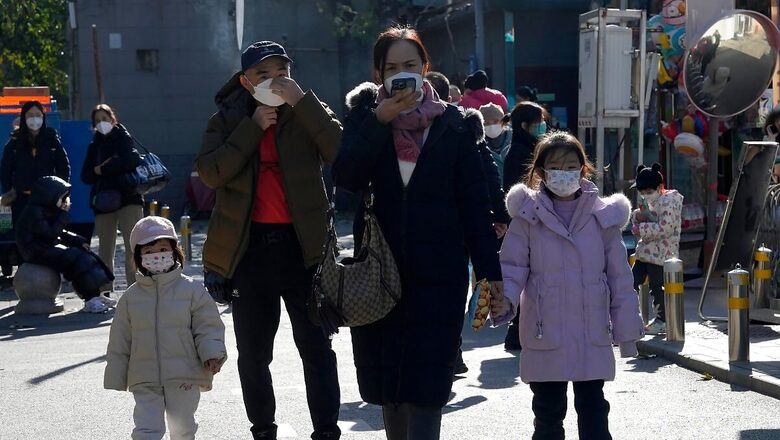
views
Bringing back memories of the Covid-19 pandemic, four years after it first emerged in the country, China is dealing with a surge in respiratory illnesses being likened to a kind of pneumonia. Affecting mostly children, it is being associated with the onset of winter and ongoing influenza.
India issued a health advisory for all states and union territories on Sunday, asking them to immediately review public health preparedness amid rising cases in northern China. The ministry of health and family welfare said it has decided to proactively review preparatory measures against respiratory illnesses as a matter of extreme caution.
The increase in cases of respiratory illness in China was flagged by WHO and attributed to usual causes such as influenza, mycoplasma pneumonia and SARS-CoV-2. China lifted Covid restrictions last December. The global health body has sought additional information from the Chinese authorities, and it has been assessed that there is no cause for alarm at the moment. Experts said there is little to suggest the cases were caused by a new virus.
Here is what we know so far:
What and where?
On November 13, China’s National Health Commission reported a surge of respiratory illnesses, mostly in children. Authorities have attributed the rising cases to the end of Covid restrictions, the arrival of the cold season, and the circulation of known pathogens including influenza, mycoplasma pneumonia, respiratory syncytial virus (RSV) and SARS-CoV-2 – the virus that causes Covid.
On November 20, the public disease surveillance system ProMED – which once issued an early warning about mysterious pneumonia cases that turned out to be Covid – reported that some Chinese hospitals were “overwhelmed with sick children" due to a pneumonia outbreak. This was said to be mainly in the capital Beijing, but also in the northeastern Liaoning province and other areas in China.
What are the symptoms?
Symptoms include fever, lung inflammation without a cough, and pulmonary nodules – lumps on lungs that are usually the result of a past infection. No deaths have been reported. Some children in Beijing have mycoplasma pneumonia, which is a common cause of pneumonia in children that is readily treated with antibiotics.
What do China and WHO say?
While social media users have dubbed this “a new virus coming from China," or a “new Covid", the WHO on November 22 requested more information from China about children suffering from “undiagnosed pneumonia".
Beijing responded the next day saying “there has been no detection of any unusual or novel pathogens" but the WHO has requested more information, noting that China closely monitors trends in viruses such as the flu, RSV and SARS-CoV-2.
Beijing was repeatedly criticised for a lack of transparency throughout the Covid pandemic. But, the country also started monitoring mycoplasma pneumonia for the first time in mid-October.
The WHO said “there is limited detailed information available to fully characterise the overall risk" of the reported cases of the respiratory illness. But, it added that an increase in such illnesses was to be expected with the arrival of winter.
Is this the outbreak of a new disease? And why now?
Experts have pointed to winter’s arrival, the end of Covid restrictions, and a lack of prior immunity in children as likely being behind rising infections. “Since China experienced a far longer and harsher lockdown than essentially any other country on Earth, it was anticipated that those ‘lockdown exit’ waves could be substantial in China," Francois Balloux of University College London told AFP.
He added that unless there is new evidence suggesting otherwise, “there is no reason to suspect the emergence of a novel pathogen".
Paul Hunter of the UK’s University of East Anglia emphasised that “at present there is too little information to make a definitive diagnosis".
He added: “Overall, this does not sound to me like an epidemic due to a novel virus. If it was, I would expect to see many more infections in adults. The few infections reported in adults suggest existing immunity from a prior exposure."
Catherine Bennett of Australia’s Deakin University pointed out that “young children in school in China will have spent up to half their life without the usual exposure to common pathogens, and so do not have the same levels of immunity".
What are the recommendations, if any?
The WHO recommended that people in affected areas should follow normal rules to avoid respiratory illnesses. These include getting vaccinated, isolating if symptoms emerge, and getting tested or wearing masks if necessary. Based on the current information, the WHO advised against any travel restrictions involving China.
What is India saying?
The health ministry in its advisory to states and UTs said: “This is noted to be important in view of the ongoing influenza and winter season that results in an increase in respiratory illness cases. The Government of India is closely monitoring the situation and indicated that there is no need for any alarm," it said.
The union health secretary has also advised for the immediate review of public health and hospital preparedness such as availability of beds, drugs and vaccines for influenza, medical oxygen, antibiotics, personal protective equipment, testing kits and reagents, functionality of oxygen plants and ventilators, and infection control practices.
State authorities have been advised to implement the ‘Operational Guidelines for Revised Surveillance Strategy in the context of Covid-19’, shared earlier this year, which provides for integrated surveillance of respiratory pathogens presenting as cases of influenza like illness (ILI) and severe acute respiratory illness (SARI). They have also been asked to ensure that the trends of ILI and SARI, particularly among children and adolescents, are closely monitored by district and state surveillance units of the Integrated Disease Surveillance Project (IDSP).
The data of ILI/SARI is required to be uploaded on the IDSP-IHIP portal. States have also been asked to send nasal and throat swab samples of patients with SARI, particularly children and adolescents, to the Virus Research and Diagnostic Laboratories for testing for respiratory pathogens.
(With agency inputs)




















Comments
0 comment